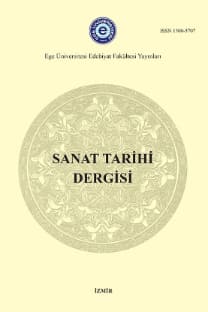Anselm Kiefer - Resim, Söz, Malzeme ve Sanat
1970’lerden sonra Avrupa ve Amerika’da gündeme gelen Yeni Dışavurumculuk, kavramsal temelli yaklaşımlara bir tepki olarak gelişen, yeniden boya, tuval ve malzemeyi öne çıkaran bir akımdır. Bu akımın önemli temsilcilerinden biri de Anselm Kiefer’dir. Resimlerinde Yahudi soykırımı ile ilgili birçok anıya gönderme yapan sanatçı, Alman kültürünün Nazilerce zedelenmesine tepkisini, Almanya’nın geçmişindeki büyük kültürel olayları anımsatan ana temalı resimleriyle dile getirmektedir. Resimlerinde çoğunlukla figür kullanmamasına karşın soyut kompozisyonlarında savaş, acı, ölüm, yalnızlık gibi konulara vurgu yapmaktadır. Büyük boyutlu yüzeylerde ele aldığı çalışmalarında doku, malzeme çeşitliliği ve obje kullanımı ile öne çıkmaktadır. Sanatçı şiirlerden esinlenerek çalıştığını, aynı zamanda harfler ve kelimelere resimlerden daha derin anlamlar yüklediğini belirtmektedir. Bu nedenle araştırmada, her bölüm başlığının altında öncelikle sanatçının sözlerine yer verilmiş ve bu sözler ile konu başlığının açıklanmasına çalışılmıştır. Sanatçının ürettiği eserlere kronolojik sıra ile değinilerek geçmiş yaşantısı ve çalışma tekniği arasındaki ilişki ortaya konmuştur. Öncelikle Joseph Beuys olmak üzere Kiefer’in etkilendiği sanatçılar ve bu sanatçılar üzerine sanat tarihi bağlamında yorumlarına yer verilmiştir. Araştırma giriş, geçmişle yüzleşme, Beuys ve sanatçılar üzerine, tanrısallık unsuru ve çimler örtsün üzerinizi başlıkları ile ele alınmıştır. Giriş kısmında sanatçını hakkında kısa bilgi, geçmişle yüzleşme kısmında sanatçının çalışmaları üzerinden Alman tarihi ile hesaplaşması, Beuys ve sanatçılar kısmında sanatçının en çok etkilendiği sanatçı Beuys ve geçmiş Alman ressamlar, tanrısallık unsuru kısmında sanatçının resimleri ile ilişkilendirdiği dinsel öğeler ve çimler örtsün üzerinizi kısmında ise sanatçının bir dönem çalıştığı atölyesini terk etmesi ile doğanın atölye üzerindeki etkilerine sanatsal bakış ortaya konmuştur. Sonuç olarak halen hayatta olan ve sanatsal üretimlerine devam eden Anselm Kiefer’in günümüz sanat ortamındaki yerine değinilmiştir.
Anselm Kiefer - Painting, Word, Material and Art
Neo Expressionism, which came to the fore in Europe and America after the 1970s, is a trend that developed as a reaction to conceptual-based approaches and emphasizes repainting, canvas and material. One of the important representatives of this trend is Anselm Kiefer. The artist, who makes reference to many memories of the Jewish Holocaust in his paintings, expresses his reaction to the Nazis’ damage to German culture with his war-themed paintings, reminiscent of the great cultural events in Germany’s past. Although he mostly does not use figures in his paintings, he emphasizes war, pain, death and loneliness in his abstract compositions. In his works on large-sized surfaces, he stands out with the variety of textures, materials and the use of objects. The artist states that his works are inspired by poems and at the same time he gives deeper meanings to letters and words than pictures. For this reason, the words of the artist are included under each chapter title in the article and the title of the subject is explained with these words. By referring to the works produced by the artist in chronological order, the relationship between his past life and working technique is revealed. When we look closely at the artist’s work, we notice that the texture, one of the plastic elements of the painting, is used intensely. In creating this texture, Kiefer uses not only paint but also different materials such as ash, wires, straw, glass pieces and concrete. He also includes three-dimensional objects such as aircraft parts or chairs in his paintings from time to time. He set up his workshop on a very large area and increased this diversity as much as he could. Joseph Beuys was one of the artists he was influenced by in terms of both conceptual approach and material diversity. The artists Kiefer was influenced by, starting off with Joseph Beuys, and his commentaries regarding the artists in the context of art history were included in this article. In the research, the titles ‘Introduction’, “confrontation with the past”, “on Beuys and artists”, “the element of divinity” and “Let the grass cover you” have been gone into. In the ‘Introduction’ part, brief information about the artist, Anselm Kiefer, is given. In “confrontation with the past”, the artist’s confrontation with German history through his works is discussed. Beuys, the artist that Kiefer was most influenced by, and other past German painters are examined in the part “on Beuys and artists”, and the religious elements that the artist associated with his paintings, in “the element of divinity”. Lastly, in the part “Let the grass cover you”, an artistic standpoint on the effects of nature on his atelier upon the artist’s abandonment of it, in which he had worked for some period of time, is put forth.
___
- Antmen, A. (2013). 20. Yüzyıl Batı Sanatında Akımlar (5 b.). İstanbul: Sel Yayıncılık.
- Artun, A. (2015, 11 6). e-skop.com. 11 27, 2015 tarihinde e-skop.com: http://www.e- skop.com/skopbulten/joseph-beuys-saman-mi-sarlatan-mi/2275 adresinden alındı
- Biro, M. (2013). Anselm Kiefer (Cilt 1). London: Phaidon Press.
- Dolmacı, S. (2014, 9 30). lebriz.com. 11 16, 2015 tarihinde lebriz.com: http://lebriz.com/pages/lsd.aspx?lang=TR§ionID=1252 adresinden alındı
- Genç, K. (01, 01 2015). mimarcasanat.com. 11 26, 2015 tarihinde mimarcasanat.com: http://www.mimarcasanat.com/resim/anselm-kiefer.html adresinden alındı
- Güleryüz, M. (2013). Resmi Geçit. İstanbul: Türkiye İş Bankası Kültür Yayınları.
- Kayabal, A. (2012, 11 12). avrupagun.eu. 11 16, 2015 tarihinde avrupagun.eu: http://www.avrupagün.eu/pdf/201203-AvrupaGun.pdf adresinden alındı
- Ötgün, C. (2000, 10 01). Çizgi Dışı Sanatçılar: Anselm Kiefer. İ.S.K. Aylık Bülten , s. 97.
- Pamuk, O. (2015, 04 14). hurriyet.com.tr. 11 16, 2015 tarihinde hurriyet.com.tr: http://www.hurriyet.com.tr/orhan-pamuk-anselm-kiefer-in-studyosundagecen-gunum-28708704 adresinden alındı
- Stilez, K., & Selz, P. (1996). Theories and Documents of Contemporary Art. London: Universty of California Press.
- Thompson, J. (2014). Modern Resim Nasıl Okunur (1 b.). (F. C. Çulcu, Çev.) İstanbul: Hayalperest Yayınevi.
- Türk Diyanet Vakfı İslam Ansiklopedisi, 07.07.2022. tarihinde https://islamansiklopedisi.org.tr/kabala adresinden alındı
- https://www.lbi.org/wp-content/uploads/2011/11/kiefer.jpg Erişim Tarihi: 08.01.2016
- http://1.bp.blogspot.com/BQxtQHZ4ouI/UsaPSNv00SI/AAAAAAAAvuU/tNpdP8d1544/s1600/1972+Anselm+Kiefer+Besetzungen+Occupazioni.jpg Erişim Tarihi: 28.11.2015
- http://liman.goodforum.net/t1145-anselm-kiefer-ve-louise-bourgeois Erişim Tarihi: 28.11.2015
- https://artitis.files.wordpress.com/2010/11/anselm-kiefer-germanys-spiritual-heroes1.jpg Erişim Tarihi: 28.11.2015
- https://tr.wikipedia.org/wiki/Kabbala / Erişim Tarihi: 09.01.2016
- http://annex.guggenheim.org/collections/media/902/84.3216_ph_web.jpg Erişim Tarihi: 28.11.2015
- http://media.coveringmedia.com/media/images/movies/2011/08/07/oycgwg_07tc.jpg Erişim Tarihi: 09.01.2016
- http://madamepickwickartblog.com/wp-content/uploads/2011/10/kiefer9.jpg Erişim Tarihi: 09.01.2016
